NIF & PS People - 2015
May
Di Nicola Named OSA Senior Member
Rep. Swalwell Praises NIF’s Work—and Workers
Five NIF Researchers Named DMTS
Five LLNL researchers who have played significant roles in NIF’s development and use have been named Distinguished Members of Technical Staff (DMTS) for their extraordinary scientific and technical contributions to the Laboratory and its missions, as acknowledged by their professional peers and the larger community. They are among 11 LLNL researchers designated DMTS this year.
The DMTS classification, created to serve as a career ladder for LLNL scientists and engineers, recognizes science, technology and engineering excellence with distinction and compensation while allowing the recipients to remain focused on contributing to the Laboratory’s missions. Only a limited number of scientists and engineers are selected for DMTS recognition; LLNL expects its DMTS population to remain within 2 to 3 percent of the eligible pool of scientists and engineers.
Gilbert (Rip) Collins
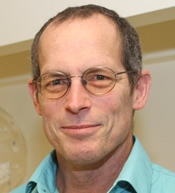
Over the past 17 years, Rip Collins has been a leading figure in establishing a new branch of science—experimental condensed matter physics at extreme, high-energy-density (HED) conditions. His pioneering work on the measurement of the equation of state of deuterium, which used laser-generated shocks to compress the sample, launched an international effort to use a new generation of HED facilities, such as NIF, to explore the properties of materials at these extreme conditions, which previously had been experimentally inaccessible. Now, as more HED facilities are becoming available, Collins is playing a pivotal international leadership role in building a broad scientific community to fully exploit these emerging capabilities for scientific discovery.
“What a great feeling it is to be selected as a DMTS,” Collins said. “This honor is a reflection of the outstanding people I have had the privilege to work with during my years at Livermore.<”
Dale Darling
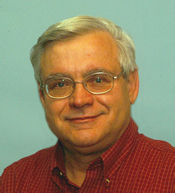
During his 35-year career at LLNL, Dale Darling has had a sustained history of distinguished scientific and technical achievements. Early in his career, his collaboration with researcher Richard Sacks in the invention of wetted foam cryogenic capsules was a key contributor to the Inertial Confinement Fusion (ICF) Program, with important implications for the establishment of NIF parameters. In later years, Darling became a recognized authority on foreign nuclear weapon programs. He has also been a key player in Comprehensive Test Ban Treaty issues and how the test ban might relate to future nuclear weapons threats.
“Being named a DMTS is a great honor and a privilege,” Darling said. “My career at LLNL has allowed me to pursue a variety of interests and has greatly benefited from a wide range of inspiring coworkers. After 35 years at LLNL, mainly working national security issues, I realize that sometimes a career path that is less traveled can result in the most interesting journey.”
Steve Haan
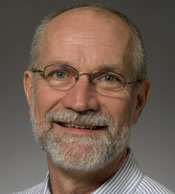
Steve Haan, a 34-year LLNL veteran, is recognized for his compelling contributions to the ICF programs, both inside and outside the Lab; his in-depth knowledge of ICF science; and his ability to integrate science, technology and manufacturing. As a world-leading expert in the area of hydrodynamics, Haan is considered a pioneer in understanding hydrodynamic instabilities and mix in ICF implosions. In addition, Haan played a leading role in the design, fielding and analysis of the Halite-Centurion series of underground nuclear test experiments, knowledge that is still drawn from today by the National Nuclear Security Administration’s Stockpile Stewardship Program.
“It’s great to be recognized this way, and I am grateful to the people who put this through,” said Haan. “I feel like everything I’ve done here has been a group effort, with other people helping me to figure out what questions we need to answer, and what kind of answers we need. It’s been a lot of fun tracking ICF through the series of experimental programs—Halite-Centurion, Shiva, Novette, Nova, Omega and NIF—and I am excited about the progress that we continue to make. I’m glad I could be a part of it. And finally, it’s been fun watching new scientists grow into the field and I’m grateful that I could be a part of that process.”
Brian MacGowan
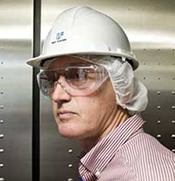
For more than 30 years, Brian MacGowan has made significant contributions to science and programs important to LLNL. MacGowan became an internationally recognized expert in the field of soft x-ray lasers, instrumental in laying the experimental foundation that led to their development. His work in this area still is cited more than 20 years later. In addition, MacGowan has been a significant contributor to the physics basis of NIF ICF research through control of laser-plasma interactions. He continues to be instrumental in developing, commissioning and operating NIF.
“I appreciate the varied career opportunities at LLNL that have allowed me to work with world-class people and facilities,” MacGowan said.
Natalia Zaitseva
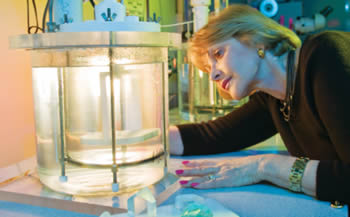
Over the course of her more than 20-year career at LLNL, Natalia Zaitseva has revolutionized the fields of crystal growth and radiation detection. She discovered mechanisms of solution growth that allowed high-quality crystals to be grown at rates up to 50 times faster than previously possible, a discovery that had immeasurable impact on the development of optical materials for NIF. The resulting scientific discoveries and technology developments have opened the way for other materials to be grown rapidly from solution and have significantly contributed to other areas of materials science. More recently, Zaitseva led a new area of crystal growth research based on applying solution methods to large-scale production of organic scintillators, which are of increasing importance for national security applications.
“I am very honored by this recognition, but at the end, any accomplishment I’ve been a part of became possible only because of the hard work and devotion of the people I’ve had a privilege to work with,” Zaitseva said. “I greatly appreciate the support of my colleagues, as well the support of the Lab itself for giving me the opportunity to do the work I like so much.”
Di Nicola Named OSA Senior Member
Jean Michel Di Nicola has been named a senior member of the Optical Society of America (OSA), an international society for optics and photonics scientists, engineers, educators and business leaders. Senior membership status recognizes members with more than 10 years of significant experience and professional accomplishments or service in their fields.
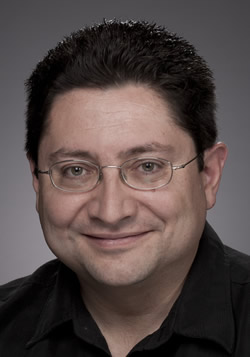 Jean Michel Di Nicola
Jean Michel Di Nicola Di Nicola is a research scientist and has been acting group leader of the NIF & Photon Science Laser Modeling and Analysis Group since October 2013. Di Nicola is working with NIF, the Advanced Radiographic Capability, and the High Repetition Rate Advanced Petawatt Laser System laser facilities modeling, as well as on laser codes development.
“As a laser physicist, coming to Livermore was an obvious choice,” Di Nicola said. “My goal is to engage grand challenges of science and technology with very talented colleagues who share the same vision and the same passion for the mission. My favorite speech is ‘We choose to go to the Moon’ by President John F. Kennedy—it speaks so well about what we are doing at LLNL.”
Di Nicola received two M.S. degrees—in optoelectronics from Caen University (France) in 1995 and in nonlinear optics and plasma physics from the University of Paris XI and Ecole Polytechnique, Palaiseau (France) in 1996. The same year, he joined the French Atomic Energy and Alternative Energies Commission, Military Applications Division (CEA/DAM) to work on the high-energy laser program dedicated to inertial confinement fusion (ICF) and stockpile stewardship.
His research expertise is in laser physics, nonlinear optics, and laser modeling of high-energy and high-peak-power lasers. He has served as the principal investigator in charge of the performance modeling and commissioning of the Laser Integration Line laser, a prototype of the French Laser Mégajoule (LMJ), during a two-year experimental program leading to ground-breaking results and world record performance of 10 kilojoules of ultraviolet energy on a single beamline.
In 2005 Di Nicola spent six months as an invited scientist to participate in NIF modeling tasks and laser codes development. In 2007 he was selected as a senior expert in nonlinear optics and laser performance modeling of ICF lasers by CEA/DAM, returned to LLNL to take part in the NIF commissioning, and finally joined LLNL in 2009.
Di Nicola has received two R&D 100 Magazine Awards as well as an LLNL Director’s Science and Technology Award for his contributions to the NIF 1.8 megajoule/500 terawatt milestone. He shares his passion for science by volunteering with middle-school and high-school math and science programs in France and the United States.
Rep. Swalwell Praises NIF’s Work—and Workers
U.S. Congressman Eric Swalwell had high praise for NIF research, and for the people who carry it out, during a May 4 tour of the facility.
“For years I’ve heard about the National Ignition Facility, and what it means to science, and the future of energy, and our nuclear stockpile maintenance,” Swallwell said. “This is the future of science, this is the future of energy, and NIF ensures that we do not have to test nuclear weapons above ground or below ground, that we can simulate what’s happening in facilities like this.”
Swallwell represents California’s 15th congressional district, an area that covers much of the East Bay and includes LLNL. He was first elected to the House of Representatives in November 2012.
Swalwell was accompanied during his tour by Lab Director Bill Goldstein, NIF & Photon Science Principal Associate Director Jeff Wisoff, NIF Director Mark Herrmann, and DOE Livermore Field Office Manager Nicole Nelson-Jean.
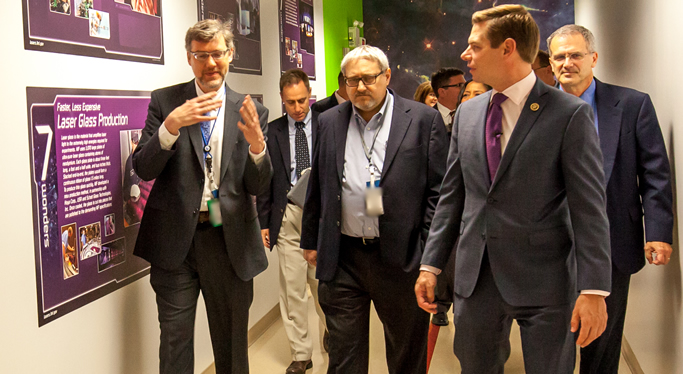 NIF Director Mark Herrmann (left) describes aspects of the facility to Rep. Eric Swalwell (second from right) as LLNL Director Bill Goldstein (center) and NIF & Photon Science Principal Associate Director Jeff Wisoff (right) listen in.
NIF Director Mark Herrmann (left) describes aspects of the facility to Rep. Eric Swalwell (second from right) as LLNL Director Bill Goldstein (center) and NIF & Photon Science Principal Associate Director Jeff Wisoff (right) listen in. The Congressman also witnessed an experiment in the NIF Control Room. Operations Manager Bruno Van Wonterghem provided a detailed description of the shot process, driven by more than five million lines of code, as the shot countdown began. After the experiment’s conclusion, Swalwell briefly met with researchers Joe Ralph, John Moody and Ryan Rygg to discuss its purpose.
The experiment, part of a collaboration between scientists at the French Alternative Energy and Atomic Energy Commission and LLNL, was the latest in a study of implosions using rugby-shaped hohlraums, in place of traditional cylindrical hohlraums, to achieve inertial confinement fusion at NIF. The aim of this experiment was to demonstrate control of the implosion shape using cross-beam energy transfer. The proper distribution of beam powers and energies inside the hohlraum is needed to achieve a symmetrical implosion, which is essential for ignition. Data from the experiment will provide the shape-scaling information necessary to obtain round implosions in a rugby hohlraum (see “Rugby Hohlraums Join the Ignition Scrum”).
“What I love about NIF,” Swalwell said, “is that the men and women who work on it wake up every day, going to work, curious about what they can learn and how they can advance science and human progress. I just want to keep encouraging them to continue believing in science, continue to be serious, and they’ll have a member of Congress who continues to push for what they’re doing back in Washington, DC.”
Video: Congressman Swalwell Visits the National Ignition Facility




